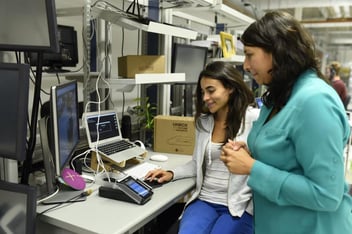When a hardtech startup and a corporate partner come together to pilot a new technology, both sides hope for transformation—new capabilities, fresh revenue streams, real-world validation. Yet, too many pilots stall in “purgatory,” never scaling beyond a test site or producing the results everyone hoped for. mHUB has learned that the most successful pilots share a common ingredient: both the startup and the corporate come to the table ready and prepared —not just to experiment, but to execute, learn, and grow.
mHUB has supported over 500 startups and manufacturers in the commercialization of hardtech solutions. When it comes to pilots, experience shows there are several key pain points that can quickly derail a project or relationship:
- Unclear objectives or misaligned incentives
- Lack of organizational buy-in
- Poor planning or resources gaps
- Failure to define success or plan for scale
- Over customization unconducive to scaling in technology
This article will outline how startups and corporates can avoid these common pitfalls by keeping communication open, setting realistic expectations, and treating pilot readiness as a continuous, collaborative process.
Pilots vs. market ready solutions:
Not every corporate is built—or incentivized—for deep experimentation. Some are seeking fast, frictionless solutions that can be integrated with minimal testing. For these organizations, the goal isn’t to co-develop technology but to find a startup offering a near-market or market-ready product that meets a clear business need, typically focused on integration and operational validation, with the ultimate goal being procurement and deployment. In this scenario, the biggest challenges are appetite for risk, complicated vendor and procurement processes, and integration. Also – finding the right startups and technology in the first place.
Alternatively, corporates look to pilots for these things:
- To solve a major pain-point that doesn’t have a market-ready solution or is highly custom
- To test a first-of-a-kind initiative that advances R&D or innovation goals
- To explore corporate venture investment
- To get buy-in for bigger deployments
What does it mean to be pilot ready?
Pilot readiness isn’t just a checklist—it’s a mindset and a process, built on a foundation of alignment, planning, and learning. At the same time, there are existing frameworks that help define when a technology is pilot ready. For example, Technology Readiness Levels which help define the maturity of a technology from TRL-1 (basic principles are observed) to TRL-9 (actual systems are proven).
HardTech startups are typically pilot ready when they reach TLR stage 6-8 where they are ready to move from a controlled environment in a lab or testbed to a real-world uncontrolled environment.
.jpg?width=900&height=400&name=2025-pilotreadyblog-01%20(1).jpg)
You can read more about technology readiness stages here, which vary slightly depending on the industry they’re being applied to:
- Example from NASA for space technologies
- Example from Massachusetts Clean Energy Center for energy technologies
Outside of technology readiness, there are other operational and strategic points that startups should consider before approaching or seeking pilot partners. mHUB suggests startups are advanced in answering, and have data to back up, the following questions:
- Desirability: Have you validated your value proposition against a real, defined customer? Are you solving a top pain point—not just for one champion, but for the broader organization? What survey data, direct customer insight, or testimonials do you have to back this up?
- Viability: Is there a credible path to a sustainable business model, including a pricing strategy and clear plan for funding the pilot and scaling up afterward?
- Feasibility: Is your prototype tested and working in a setting that approximates the real world? Do you understand technical risks, regulatory requirements, and integration barriers? What technology readiness level are you?
.jpg?width=900&height=400&name=2025-pilotreadyblog-02%20(1).jpg)
While corporates don’t need to answer questions about technology readiness, they do need to understand the internal resources required and how they’ll answer the question, “was the pilot successful?”
Yes, pilot projects require time and commitment, but they can also be one of the most efficient and least risky ways for an organization to invest in and scale innovation quickly. In today’s landscape of rapid-fire change and ceaseless advancement, organizations simply can’t keep up unless they foster a culture of adaptability and innovation. So, what questions do corporates need to ask themselves?
- Organizational buy-in: Is there an internal champion—and do you have alignment across all stakeholders who will be affected by the pilot? Are there outliers who will stall the project or want to see if fail?
- Resource commitment: Are budget, time, and staff truly allocated to make the pilot a priority? Are you prepared for bumps in the road and empowered to help solve them?
- Clear success criteria: Have you defined what success looks like—and what happens if the pilot achieves those goals?
Setting up for success: pre-pilot alignment
Before a pilot ever kicks off, both parties need to invest in alignment. For startups, that means developing a pilot framework, refining the customer profile, clarifying what the pilot is meant to prove, and preparing all technical and business documentation. mHUB encourages startups to “productize” their pilot programs—treating the pilot as a packaged, value-added service, not just a free trial or demo. This approach helps avoid “pilot purgatory” and sets the stage for scaling.
For corporates, it means mapping out the use case, identifying who needs to be involved, and confirming the incentives (what’s in it for the business, the team, and the pilot sponsor).
In this process, both parties should pay attention to cultural fit. Just as much as a project and outcome needs to be defined, a relationship of trust and enthusiasm must be built with stickiness across an organization, not just a single champion.
Organizations like mHUB exist to commercialize technology in concert with startups and corporates and can be a great intermediary. mHUB speaks both languages, that of the entrepreneur and that of industry, and can translate unique needs and desired outcomes across parties, giving everyone confidence and a safety net.
.jpg?width=900&height=400&name=2025-pilotreadyblog-04%20(1).jpg)
How to define a mutually valuable pilot:
The best pilots are built on a foundation of joint value creation. That means:
- Solving real problems: The pilot should address high-priority, high-urgency problems—not just “nice to have” features.
- Aligning incentives: Both sides should have skin in the game, whether that’s a clear business case for the corporate, or a strong testimonial and data for the startup. Articulate not just what the pilot could deliver, but why it matters to both organizations’ core strategies.
- Clear roles and KPIs: Define what each side is responsible for, how outcomes will be measured, and what happens next if goals are met.
Documentation that should be co-created:
Time needs to be spent up-front putting expectations to paper. Documentation and decisions might include:
- Readiness checklists: Cover everything from technical requirements to legal terms and communication protocols.
- Compensation: Parties need to align on who is paying for the pilot. Is it priced at market value as if it were a procurable service, priced to cover costs, or free as a strategic priority?
- Detailed project plans: Timeline, milestones, resources, and budget breakdowns. Anticipate integration, regulatory, or logistical hurdles before they happen. Define touchpoints, meetings, and reporting schedules.
- Business and Technical Roles: Understand early on who will play both business and technical roles and who will have a say in how the technology evolves or adapts to the pilot environment.
- Measurement: Plan to measure the status of the site before the pilot, during the pilot, and after to understand value. Define who will be conducting measurements – startups should expect and want to own this.
Running and executing the pilot
For hardtech pilots that happen onsite, you can expect regular site visits and scenarios that will require corporates lean on accounting, operations, and legal to unblock challenges and advance the pilot.
Pilots are highly monitored, measured, and documented. Don’t expect one major debrief. Successful pilots follow something of a 30-60-90 plan, on whatever timescale is project appropriate, where the feedback loop is achieved, next steps are mapped, and pre-plans are confirmed or adjusted.
However, don’t expect to make any major tweaks during the pilot. While little tweaks throughout the duration of the project are expected, big tweaks likely indicate there is a large issue with the deployment.
For the startup, throughout this process look for moments to capture testimonials. If you don’t end up scaling with the current pilot partner, you can at least secure industry validation to help future sales and investment efforts. For the corporate, anticipate regular communication from your startup partners. For them, this is one of the most important irons they have in the fire. Decide how you’ll meet them in that enthusiasm or constructively direct it.
Ready to Go Beyond the Demo?
Hardtech commercialization happens in the real world, not just the lab. Whether you’re a startup ready to prove your solution or a corporate looking for new answers, pilots are a bridge from possibility to progress. If you’re a startup or corporate on an innovation journey, mHUB can help.
Contact us to get started.
For more resources on building and scaling your business, check out upcoming mHUB courses and events at mhubchicago.com/eventsIf you are a budding entrepreneur looking for a vast community of innovators, take a tour at mHUB to learn more about the hardtech ecosystem and how you can get involved.




